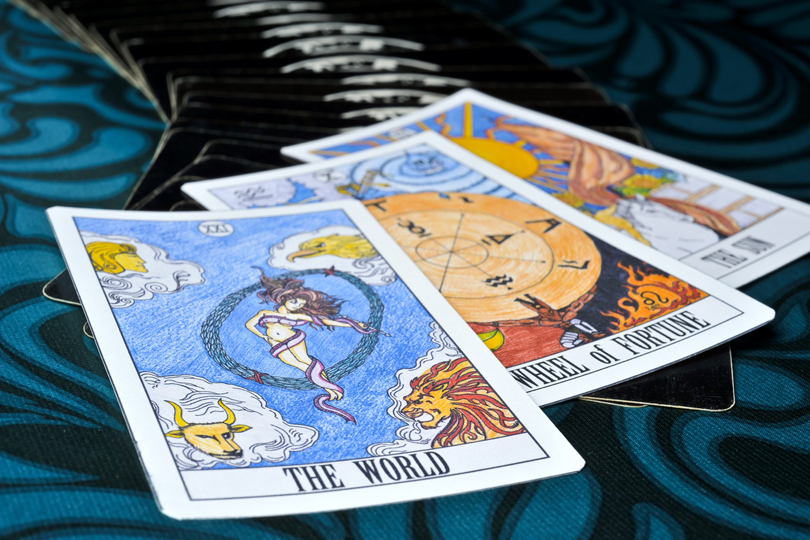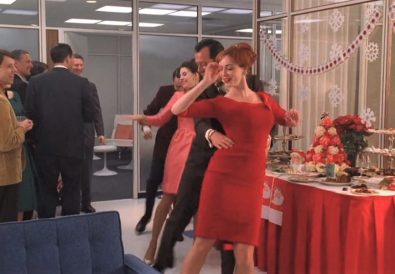Before we get started, allow me to do a little mythbusting. Tarot cards are not magic, nor are they evil, nor are they witchcraft or the work of the devil. They won’t predict your future (necessarily) and if the death card turns up, you’re not going to die. (I mean, we’re all going to die, obviously, but you know what I mean.)
What Tarot will do for you is give you insight, understanding, and clarity. You will develop your intuition, creativity, and self-awareness. You will be able to make sense of situations or come to a more informed decision. I always say that Tarot doesn’t really tell me anything I don’t already know. Rather, it reveals things beneath the surface of our consciousness that you may not otherwise realize. Personally, I like to consult my deck when I’m having a hard time making a decision about something (which, as a Libra, is pretty much my life), or when I want to make sense of a confusing situation. So if you’re looking for some guidance in life, Tarot might be for you!
THE DECK
First, you need to acquire a deck. When choosing, it’s best to do so in store rather than online because your physical presence will allow you to feel the energy coming off the deck. Remember, Tarot cards work entirely on energy. Pick a deck that you are drawn to, one that speaks to you. It may take more than one attempt to find the right deck… you won’t necessarily find one your first time looking. But be patient and when the time is right, it will happen. Much like falling in love, when you find the one, you just know.
On the other hand, sometimes more than one deck will appeal to you and if you’re having trouble deciding which one to go pick, try this test. Hold the deck in your dominant hand and place it over your heart. Extend your opposite arm out to the side so it’s parallel to the floor. Ask the universe, Is this deck right for me? Will this deck bring me to my highest point? or something of the like, and have someone push firmly down on your extended arm. Whichever deck you are holding when you are able to resist their downward force is the deck you should go with! The stronger your arm remains, the more powerful the deck is for you.
Once you’ve got your deck, you’ll want to attune to it to maximize your connection and in turn, the accuracy and insightfulness of your readings. Sleep with the cards under your pillow every night for one week and interact with them daily by looking at and touching each one to instill your energies into them.
To take care of your deck, keep them safe in the box and wrapped in dark coloured cloth to protect them from external elements and any negative energies floating around. When you get ready to do a reading, be sure to cleanse the deck before starting your session. Fan them out in one hand and gently blow on the edges. Gather them back together into one pile and firmly knock the top of the deck once to knock out old energy from previous readings. This will help to ensure your reading is clear, not cloudy.
THE CARDS
When you’re attuning to your deck, you will start to get to know the cards. A Tarot deck is comprised of 78 cards total, divided into two groups: the Major and Minor Arcana (the word arcana meaning secret). There are 22 Major Arcana cards, which point to significant life events or shifts, whereas the remaining 56 Minor Arcana cards are more detailed aspects, reflecting day-to-day events.
The Major Arcana Cards
The Major Arcana comprise the numbers 0 (The Fool) through XXI (The World). Pay attention when these cards come up! Each card can generally be interpreted as follows:
0 The Fool: Beginnings; risk
I The Magician: Action, ambition, and manifesting
II The High Priestess: Secrets, intuition, and learning
III The Empress: Creativity, resources, motherhood
IV The Emperor: Order, power, and boundaries
V The Hierophant: Unity, marriage, and education
VI The Lovers: Love; decisions
VII The Chariot: Progress; determination
VII Strength: Management; endurance
IX The Hermit: Analysis; solitude
X The Wheel of Fortune: Luck; fate
XI Justice: Decisions; balance, legal affairs
XII The Hanged Man: Waiting; sacrifice
XIII Death: Transformation, change, and new beginnings
XIV Temperance: Negotiation
XV The Devil: Restriction
XVI The Tower: Breakdown and illumination
XVII The Star: Hope and guidance
XVIII The Moon: Crisis of faith; deep emotions
XIX The Sun: Growth and recovery
XX Judgment: The past; second chances
XXI The World: Success and completion
The Minor Arcana Cards
The Minor Arcana are divided into four suits, similar to a regular deck of playing cards”you know, Diamonds, Hearts, Spades, Clubs. In Tarot, you have Cups, Pentacles, Swords, and Wands (sometimes called Rods). Each suit is ruled by one of the four elements, which in turn relates to a certain aspect of life. Here are basic lines of understanding for each suit to help guide your readings.
Cups “ Water “ Emotions and relationships “ The heart “ I feel
Pentacles “ Earth “ Property, money, and achievement “ The body “ I possess
Swords “ Air “ Intellect and decisions “ The mind “ I think
Wands “ Fire “ Instinct, travel, and communication “ The soul “ I desire
Again, like a regular deck of cards, the numbers run from Ace through 10, with four court cards, each ruled also ruled by an element: Page (Earth), Knight (Fire), Queen (Water), and King (Air).
Use these elements to help find meaning in the card. For example, the King of Wands is essentially Air of Fire. We know that air fuels fire”think of blowing on burning embers while trying to get a campfire going. Since these elements relate to matters of both the mind and the soul, this card could be a warning to not let the pursuit of one’s desires burn you out. This is just one interpretation, of course, and there are other factors at play that will help you formulate your reading.
The numbers of the non-court Minor Arcana cards are important too. Here is generally what each represents:
Ones (Aces): Beginnings; new energy
Twos: Partnerships, balance, and division
Threes: Acknowledgement
Fours: Stability and boundaries
Fives: Instability and challenges
Sixes: Harmony and improvement
Sevens: Potential and ambitions
Eights: Rewards and progress
Nines: Intensity
Tens: Culmination; endings, but also beginnings; and completion
THE SPREAD
Now you have a basic understanding of the cards and you’re ready to start reading! First you will have to think of your question. It can be as general or specific as you like, but a good rule of thumb is to not phrase it as a yes or no question. Rather, questions beginning with How or Why or What will fair much better for giving maximum insight. So, instead of asking, Will I ever find love? phrase it as, What can I do to find a loving and lasting relationship? This way, you will be able to walk away from the reading with a clear understanding of what path you should take!
Once you have your question, you can choose what kind of spread you want to use. This could depend on what kind of reading you’re looking for, as some spreads are more appropriate for certain things than others. Here is a good resource that explains the six most common spreads and when to use them.
So, you have your question and you have your spread in mind. Your deck is cleansed and now it’s time to start shuffling. The process of shuffling is important”here is where you put your energies and intentions into the deck as you ask your question. Relax and focus, allowing your thoughts and feelings to flow to the surface. After a few moments, whenever you feel ready, you can begin to create your layout. And if a card falls or jumps out of the deck as you shuffle, read it right away! This is an important message from the universe.
If your spread only uses a few cards, fan the cards out face down. Choose each card one by one with your left hand, as this is known as the hand of fate. Place each card face down in front of you to create your layout. If you’re doing a reading for someone else, have them shuffle, fan, and select, then hand them to you so you can place them appropriately for the spread layout.
For more elaborate spreads that use more cards, cut the deck once you’re finished shuffling. Do so twice, into three piles, down and to the left with your left hand. Pick a pile to go on top, then collect the remaining two underneath it. If reading for another person, have them do everything except collect the cards (shuffle, cut, and pick a top pile). Once you have gathered all the cards, lay out the cards one by one from the top of the deck, placing them face down to create your spread.
Whether you turn all of the cards over at once or as you go is up to you. Some readers like to look at the whole picture while others like to find meaning as they go without letting other cards influence their interpretation. When you do flip the cards, be sure to do so sideways (from left to right) and not from top to bottom or vice versa, as this could flip the card and therefore change its meaning. A card’s upright position carries different meaning than its reversed position (which does not necessarily indicate an opposite meaning but does generally carry more of a negative connotation), as you will see when you begin to learn each card’s individual meaning.
THE READING
Each Tarot deck comes with a little guide book that describes what each card represents. This is helpful, but not exhaustive. A card showing up in one reading may not have the same reading in the next. Be sure to incorporate your own intuition and judgment when reading cards and searching for possible meanings. Look at the images”what do you see? What do you notice first? Does anything in particular jump out at you? How does it make you feel? How might the elements be at work here? What do the numbers mean? What about the colours? Colours in Tarot may point to the following:
Red: Energy, passion, and the material world
Yellow: Consciousness, illumination, and self-expression
Blue: Truth and clarity
Green: Nature and growth
Gray: Neutral; unknown outcomes
Purple: Intuition and spirituality
Black: Protection; oppression
White: Purity and innocence
Orange: Creativity and impulse
As you do more readings and become more comfortable with your deck, your intuition will develop. Trust your inner voice. Don’t be afraid of saying the wrong thing. If reading for someone else, ask for their input to help guide you. Make it a discussion. Ask for guidance. Ask for clarity. Ask, and you shall receive.
Source: The Ultimate Guide to Tarot by Liz Dean.











